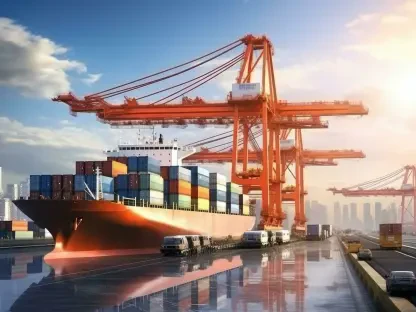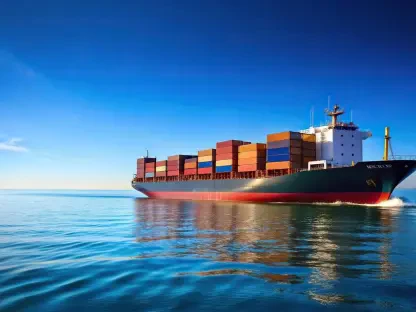Setting the Stage for a Troubled Market
The global logistics industry, a cornerstone of international trade, is currently navigating one of its most challenging periods in recent memory, with freight rates plummeting and overcapacity looming large. Major players like Kuehne + Nagel, DSV, GXO Logistics, and C.H. Robinson face a stark reality of shrinking profit margins amid subdued demand. This market analysis delves into the forces driving this downturn, unpacking the strategies these giants are deploying to weather the storm. By examining key trends, financial indicators, and regional disparities, the purpose is to provide a clear picture of the current state of the freight market and offer insights into its future trajectory. The stakes are high, as the decisions made now could redefine competitive dynamics for years to come.
Unpacking the Freight Market Downturn
Roots of the Current Crisis
The freight market’s struggles stem from a dramatic shift following the unprecedented demand spikes during the early 2020s. As global supply chains rushed to meet consumer needs during that boom, logistics companies expanded capacity across ocean, air, and road transport. However, with economic normalization, demand has softened significantly, particularly in industrial sectors, leaving the industry burdened by excess capacity. This imbalance has driven freight rates downward, eroding profitability for even the largest players. Economic pressures such as inflation and currency fluctuations further compound the challenge, creating a perfect storm of margin compression.
Financial Fallout Across the Sector
Financial reports from leading logistics firms paint a grim picture of the current landscape. Kuehne + Nagel has seen a sharp decline in earnings before interest and taxes, reflecting the impact of lower rates in sea and road logistics. DSV, meanwhile, reports organic declines in its air and sea divisions, highlighting the pervasive nature of overcapacity. GXO Logistics and C.H. Robinson also face profitability pressures, though specific segments show resilience. These figures underscore a broader trend: the industry is grappling with structural challenges that demand a fundamental rethinking of operational models to prioritize cash flow over volume.
Regional and Segmental Variations
Beyond the overarching downturn, disparities across regions and sub-sectors add layers of complexity to the market analysis. Europe’s road freight sector remains particularly weak, with underutilization plaguing companies like Kuehne + Nagel and DSV due to sluggish industrial demand. In contrast, North America shows early signs of stabilization, with C.H. Robinson noting modest volume growth in truckload and less-than-truckload services. Meanwhile, contract logistics emerges as a relative bright spot, with GXO Logistics posting revenue gains driven by e-commerce and industrial warehousing. These variations suggest that tailored, region-specific strategies are critical for navigating the uneven recovery.
Strategic Moves to Counter Market Pressures
Cost Reduction as a Core Defense
In response to shrinking margins, logistics giants have turned to aggressive cost-cutting as a primary survival tactic. Kuehne + Nagel has launched a substantial savings program targeting millions in reductions, including significant workforce adjustments. DSV is consolidating its European road terminals to streamline operations, while C.H. Robinson focuses on leaner processes to minimize overhead costs. These efforts aim to protect financial health in a low-rate environment, though they risk impacting service quality and employee morale if pushed too far. The balance between savings and maintaining a competitive edge remains a delicate one.
Leveraging Technology for Efficiency
Technology and automation are becoming indispensable tools for logistics firms aiming to enhance operational efficiency. C.H. Robinson stands out with its AI-driven model, optimizing routing and pricing to reduce costs without sacrificing service levels. Kuehne + Nagel is also investing in automation as part of its broader cost-reduction strategy, preparing for scalability when demand rebounds. While these initiatives promise long-term benefits, the high upfront costs and integration challenges pose risks to already strained budgets. Nonetheless, embracing digital transformation appears non-negotiable for staying relevant in a tightening market.
Capitalizing on Market Niches
Amid the widespread downturn, some companies are finding stability by focusing on specific niches or acquisitions. DSV’s integration of Schenker has expanded its European footprint, providing a buffer against regional weaknesses. GXO Logistics capitalizes on steady demand in contract logistics, particularly from e-commerce and technology sectors, to maintain revenue growth. These targeted approaches highlight the importance of diversification and strategic positioning. By identifying and exploiting areas of relative strength, firms can mitigate the broader market’s volatility and build resilience against ongoing pressures.
Projections and Emerging Trends
Short-Term Outlook and Recovery Signals
Looking ahead, the freight market is expected to remain challenging through the near term, with overcapacity likely to persist into the next year. However, tentative recovery signals in North America, as evidenced by volume upticks for C.H. Robinson, suggest that certain regions may stabilize sooner than others. Europe, on the other hand, faces a slower path to recovery due to persistent industrial softness. Analysts anticipate that demand could begin to rebound by 2026, though external factors like regulatory changes and economic shifts could delay or accelerate this timeline. Companies must prepare for a prolonged period of caution.
Technology as a Long-Term Differentiator
Over the longer horizon, technological integration is poised to reshape the logistics landscape fundamentally. AI and automation, already proving their worth in optimizing operations, are expected to become standard tools for enhancing efficiency and scalability. Firms that invest wisely now, despite tight budgets, could gain a significant edge when market conditions improve. The challenge lies in balancing these investments with immediate financial constraints, ensuring that innovation does not come at the expense of stability. The trajectory of digital adoption will likely separate leaders from laggards in the coming years.
Sustainability and Regulatory Impacts
Another trend on the horizon is the growing emphasis on sustainability, though it currently takes a backseat to cost concerns. Stricter emissions standards, particularly in Europe, are expected to introduce new compliance costs that could further strain margins. At the same time, sustainability initiatives offer potential as a competitive differentiator for firms willing to invest in green logistics solutions. Balancing these regulatory demands with financial priorities will be a key test for the industry. As consumer and governmental expectations evolve, aligning with environmental goals could become a strategic imperative.
Reflecting on the Path Forward
Looking back, the freight market crisis of this year revealed the vulnerability of an industry caught between past overexpansion and present economic headwinds. The strategic pivots by logistics giants underscored a collective shift toward efficiency, with cost discipline and technology emerging as vital lifelines. For stakeholders, the next steps involve doubling down on data-driven decision-making to optimize operations, exploring diversification into stable segments like contract logistics, and cautiously investing in scalable tech solutions. Additionally, monitoring regional recovery patterns will be crucial to allocate resources effectively. As the sector braces for an uncertain yet potentially transformative period ahead, adaptability remains the cornerstone of enduring success.









